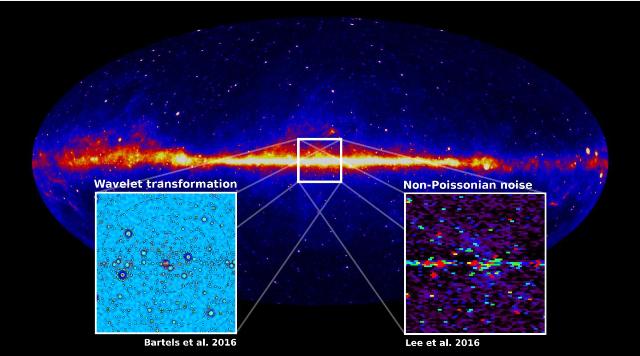Feb 4 2016
Contrary to the assumption that bursts of gamma rays emanating from our galaxy’s center are dark matter signals, it is now thought that they could be fast-rotating stars, known as millisecond pulsars, or other astrophysical phenomena, in accordance with the results of two recent studies.
 Studies by two independent groups from the US and the Netherlands indicate that the observed excess of gamma rays from the inner galaxy likely comes from a new source rather than from dark matter. The best candidates are rapidly rotating neutron stars, which will be prime targets for future searches. The Princeton/MIT group and the Netherlands-based group used two different techniques, non-Poissonian noise and wavelet transformation, respectively, to independently determine that the gamma ray signals were not due to dark matter annihilation. (Image courtesy of Christoph Weniger, UvA. © UvA/Princeton)
Studies by two independent groups from the US and the Netherlands indicate that the observed excess of gamma rays from the inner galaxy likely comes from a new source rather than from dark matter. The best candidates are rapidly rotating neutron stars, which will be prime targets for future searches. The Princeton/MIT group and the Netherlands-based group used two different techniques, non-Poissonian noise and wavelet transformation, respectively, to independently determine that the gamma ray signals were not due to dark matter annihilation. (Image courtesy of Christoph Weniger, UvA. © UvA/Princeton)
Researchers from Princeton University and the Massachusetts Institute of Technology (MIT) conducted one study and researchers based in the Netherlands carried out another study.
Earlier studies proposed that when invisible dark matter particles collide, they cause gamma rays to emanate from the dense region of space in the inner Milky Way galaxy. The two research teams, employing novel statistical analysis methods, independently determined that the gamma ray signals are atypical of those emanating from dark matter. The findings of the two teams are reported in Physical Review Letters.
Our analysis suggests that what we are seeing is evidence for a new astrophysical source of gamma rays at the center of the galaxy. This is a very complicated region of the sky and there are other astrophysical signals that could be confused with dark matter signals.
Mariangela Lisanti, Assistant Professor of Physics, Princeton.
It is assumed that the center of the Milky Way galaxy contains dark matter due to the existence of a dense concentration of mass, such as dense star clusters and a black hole. A decisive finding of collisions of dark matter, in the center of the galaxy could turn out to be an important step forward in the understanding of the universe.
Finding direct evidence for these collisions would be interesting because it would help us understand the relationship between dark matter and ordinary matter.
Benjamin Safdi, Postdoctoral Researcher, MIT
The Princeton/MIT research team focused on image-processing techniques to determine if the signals originate from dark matter or from other sources. They focused on what the gamma rays should look like if the rays appear from a collision of hypothesized dark matter particles, called as weakly interacting massive particles (WIMPs). For this purpose, Lisanti, Safdi and Samuel Lee, a former postdoctoral research fellow at Princeton who is now at the Broad Institute, along with colleagues Wei Xue and Tracy Slatyer at MIT, analyzed the gamma ray images taken by NASA's Fermi Gamma-ray Space Telescope that has been engaged in mapping the rays from 2008.
Dark matter particles are assumed to constitute about 85% of the mass in the universe, but have not been directly detected yet. The WIMPs collision, according to a widely agreed model of dark matter, causes mutual annihilation, resulting in the generation of gamma rays. The gamma rays are the highest-energy light form in the universe.
As per this model, the high-energy particles of light (photons) should be distributed in a smooth manner between the pixels of the Fermi telescope images. But other sources, including rotating stars, referred to as pulsars, discharge bursts of light that appear as isolated, bright pixels.
When the statistical analysis method was applied to the Fermi telescope images, the researchers found that the photon distribution was clumpy, instead of being smooth, indicating that the gamma rays could not have been caused by dark matter particle collisions.
The exact nature of the new sources is unknown, Lisanti said, but it is possible that they are relatively old, quickly rotating stars, known as millisecond pulsars. She added that it may be possible to find out the source of the rays by utilizing other types of sky survey methods that involve telescopes detecting radio frequencies.
Douglas Finkbeiner, a professor of astronomy and physics at Harvard University, who was not directly associated with the current study, said that though the new findings can cause difficulties in the search for dark matter, they can lead to other discoveries. "Our job as astrophysicists is to characterize what we see in the universe, not get some predetermined, wished-for outcome. Of course it would be great to find dark matter, but just figuring out what is going on and making new discoveries is very exciting."
Either we find hundreds or thousands of millisecond pulsars in the upcoming decade, shedding light on the history of the Milky Way, or we find nothing. In the latter case, a dark matter explanation for the gamma ray excess will become much more obvious.
Christoph Weniger, University of Amsterdam